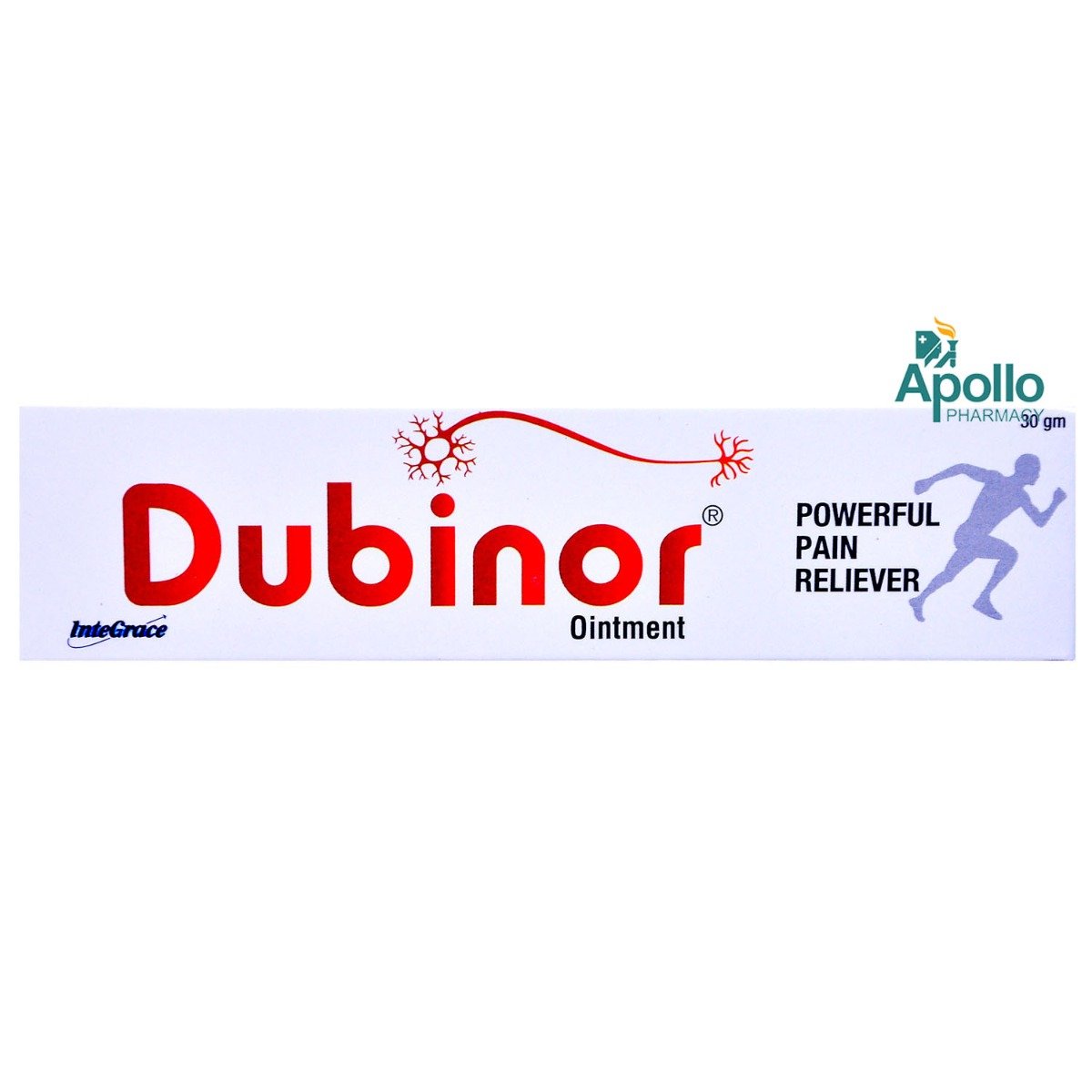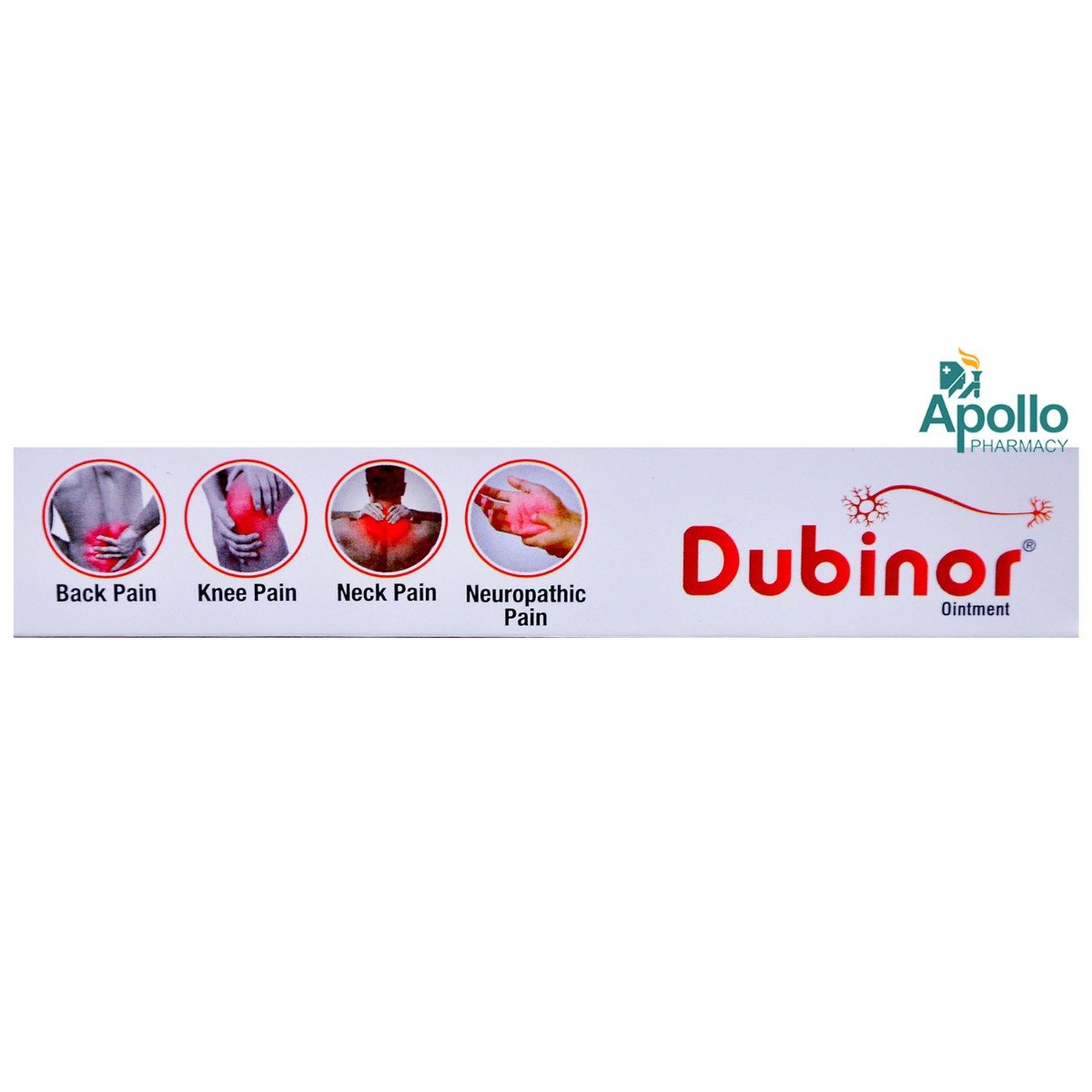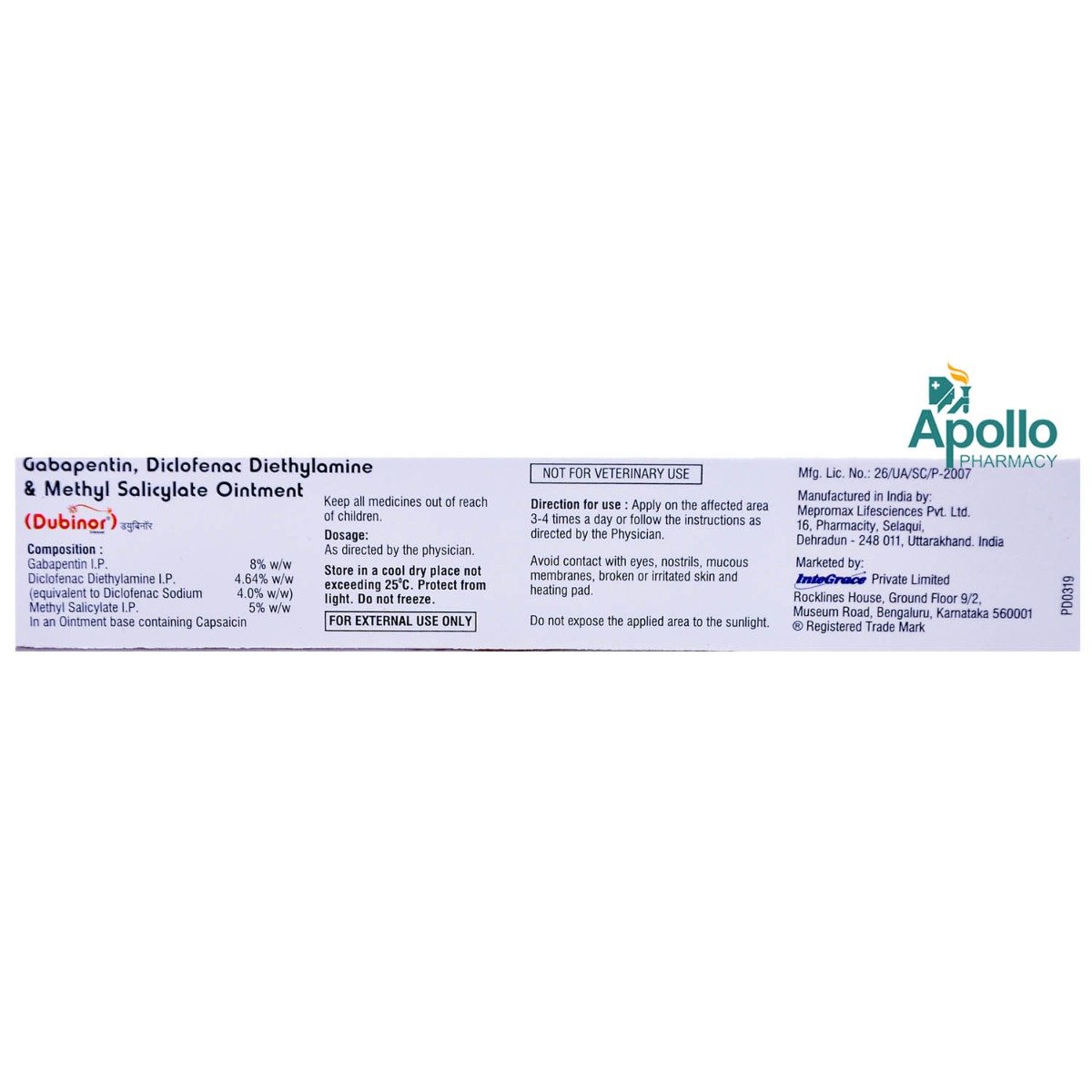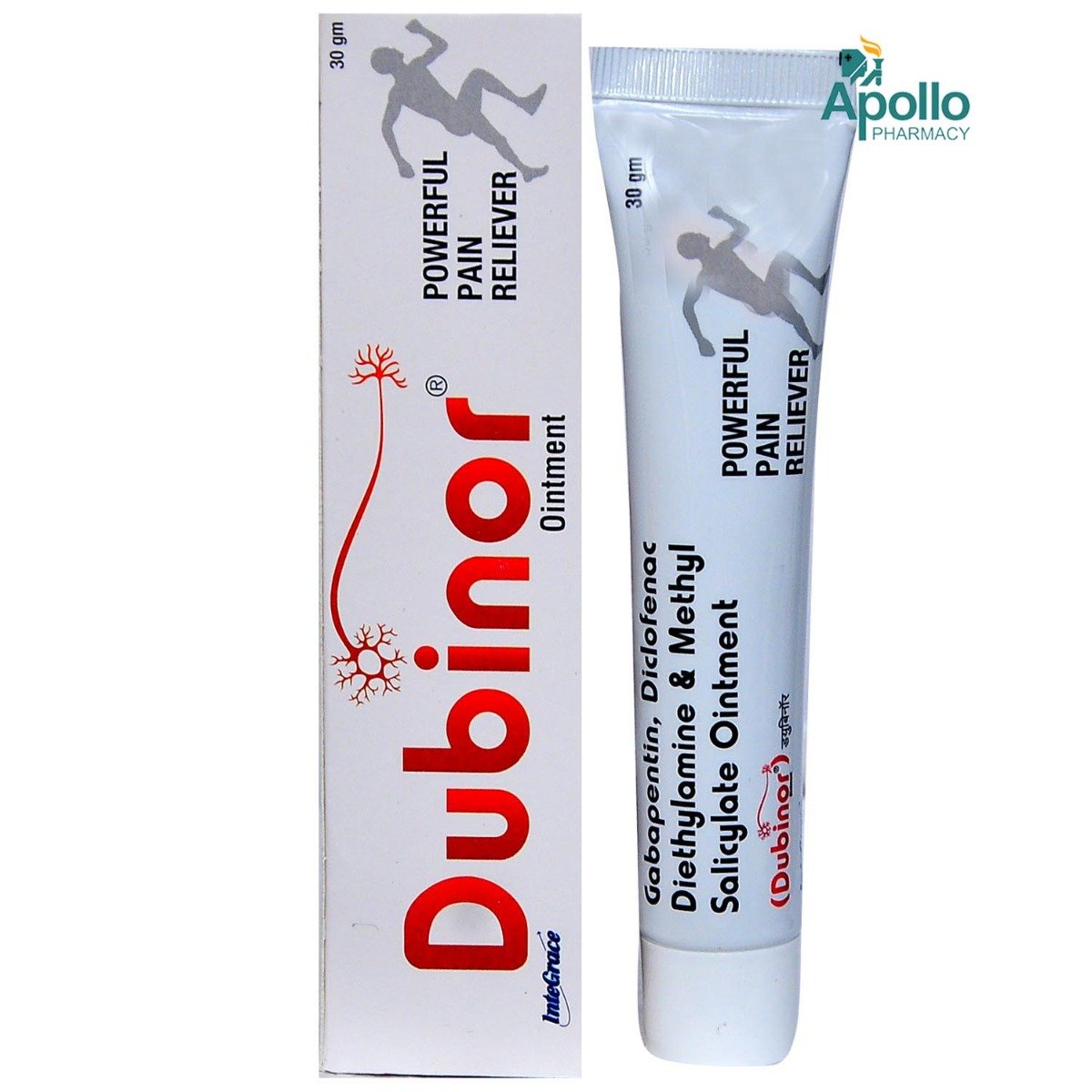Dubinor Ointment 30 gm








MRP ₹292.5
(Inclusive of all Taxes)
₹43.9 Cashback (15%)
Provide Delivery Location
Online payment accepted
 Prescription drug
Prescription drugWhats That
Manufacturer/Marketer :
Consume Type :
Expires on or after :
Return Policy :
About Dubinor Ointment
Dubinor Ointment is a combination medicine used to relieve pain. It helps treat muscle and joint pain, arthritis pain, and pain due to nerve damage (neuropathic pain). Pain is a symptom triggered by the nervous system, causing uncomfortable sensations in the body.
Dubinor Ointment consists of Gabapentin, Diclofenac diethylamine, and Methyl salicylate. Gabapentin is an anti-epileptic agent that alters the way the nerves send messages to the brain, thus relieving pain. Diclofenac diethylamine is a non-steroidal anti-inflammatory drug (NSAID) that works by blocking the release of certain chemical substances, such as prostaglandins and leukotrienes that cause pain and swelling. Methyl salicylate is a topical rubefacient that temporarily relieves muscle or joint pain caused by strains and sprains.
Dubinor Ointment is for external use only. Take a pea-sized amount onto your fingers and apply it to the affected areas. You are advised to use Dubinor Ointment for as long as your doctor has prescribed it for you, depending on your medical condition. Sometimes, you may experience certain common side-effects, such as application site reactions like itching, irritation, redness, and burning sensation. These side-effects do not require medical attention and will resolve gradually over time. However, if these side effects persist for a longer time, please see your doctor.
Pregnant and breastfeeding women should consult the doctor before using the Dubinor Ointment. Dubinor Ointment is not recommended for children as safety and efficacy have not been established. Avoid or limit exposure to natural or artificial sunlight as Dubinor Ointment may cause a burning sensation. Do not take any other NSAID's for pain relief along with Dubinor Ointment unless prescribed.
Uses of Dubinor Ointment
Directions for Use
Key Benefits
Dubinor Ointment is used to treat neuropathic pain caused due to nerve damage and arthritis pain. It contains Gabapentin, Diclofenac diethylamine, and Methyl salicylate. Gabapentin is an anti-epileptic agent that alters the way the nerves send messages to the brain, thus relieving pain. Diclofenac diethylamine is a non-steroidal anti-inflammatory drug (NSAID) that works by blocking the release of certain chemical substances, such as prostaglandins and leukotrienes that cause pain and swelling. Methyl salicylate is a topical rubefacient that temporarily relieves muscle or joint pain caused by strains and sprains.
Storage
Drug Warnings
Do not take any other oral painkillers for pain relief along with Dubinor Ointment unless prescribed. Do not use Dubinor Ointment if you are allergic to any of its contents. Inform your doctor if you have any active skin diseases before using Dubinor Ointment. Consult a doctor before starting Dubinor Ointment if you are pregnant or breastfeeding. Dubinor Ointment is not recommended for children as safety and effectiveness have not been established.
Drug-Drug Interactions
Drug-Drug Interactions
Login/Sign Up
Drug-Food Interactions
Drug-Food Interactions
Login/Sign Up
Diet & Lifestyle Advise
- Physical activity helps in strengthening muscles and relieves joint stiffness. Gentle activities like 20-30 minutes of walking or swimming would be helpful.
- Performing yoga may also help in improving joint flexibility and pain management.
- Maintain a healthy weight by performing regular low-strain exercises and eating healthy food.
- Get adequate sleep as resting the muscles can help in reducing inflammation and swelling.
- Follow heat or cold therapy; apply a cold or hot compress on the joints for 15-20 minutes regularly.
- De-stress yourself by meditating, reading books, taking a warm bubble bath or listening to soothing music.
- Acupuncture, massage and physical therapy may also be helpful.
- Eat food rich in antioxidants such as berries, spinach, kidney beans, dark chocolate, etc.
- Foods containing flavonoids help in reducing inflammation. These include soy, berries, broccoli, grapes and green tea.
- Avoid smoking and alcohol consumption.
- Using essential oils for massages can help increase circulation and boost healing.
Side Effects of Dubinor Ointment
- Itching
- Irritation
- Redness
- Burning sensation
Habit Forming
Therapeutic Class
All Substitutes & Brand Comparisons
Author Details
We provide you with authentic, trustworthy and relevant information
Drug-Diseases Interactions
Drug-Diseases Interactions
Login/Sign Up
FAQs
Dubinor Ointment contains Gabapentin, Diclofenac diethylamine, and Methyl salicylate. It works by blocking the pain signals to the brain and inhibits the release of chemical substances that cause pain and swelling. Thereby, Dubinor Ointment helps relieve pain.
You are recommended to take a shower, bath or wash the treated area of skin after 1 hour of applying Dubinor Ointment for effective results.
Avoid or limit exposure to natural or artificial sunlight as Dubinor Ointment may cause ultraviolet light-induced skin tumours.
You are not recommended to apply Dubinor Ointment on wounds, cuts, burn, rashes, infected areas or peeling skin. However, please consult a doctor if you have any concerns.
Drug-Drug Interactions Checker List
- ANISINDIONE
- DICOUMAROL
- WARFARIN
- HYDROCODONE
- ACETAMINOPHEN
- DULOXETINE
- ESCITALOPRAM
- SERTRALINE
- CYCLOBENZAPRINE
- ALPRAZOLAM
- PREGABALIN
- QUETIAPINE
- PREDNISONE
- LITHIUM
- METHOTREXATE
Special Advise
- If Dubinor Ointment comes in contact with eyes, nose or mouth, rinse with water immediately.
- Wash your hands before and after using Dubinor Ointment; however, do not wash your hands if you apply Dubinor Ointment on your hands.
Disease/Condition Glossary
Pain: It is not a disease but a symptom triggered by the nervous system, causing uncomfortable sensations in the body. Pain may be dull or sharp; it might be constant or come and go. The tolerance level of pain might vary from person to person. Pain can be generalized (overall body aches) or localized (affecting a specific area of the body).
Neuropathic pain: Neuropathic pain is caused due to damaged sensory nerves. It is caused by chronic progressive nerve disease or due to infection or injury. A feeling of numbness and loss of sensations is common with neuropathic pain. Usually, the body sends the pain signals when there is an injury, but with neuropathic pain, the pain is not triggered by an injury; the body unpromptedly sends the pain signals. Symptoms include spontaneous, untriggered pain, unpleasant feeling, shooting, burning or stabbing pain, difficulty resting or sleeping, and evoked pain (pain caused by events that are usually not painful).
Osteoarthritis: It is a degenerative joint disease in which the two ends of the joints come together due to the breakdown of a protective covering called cartilage. Due to the absence of this protective covering, the joints rub against each other, leading to pain and stiffness. Symptoms of osteoarthritis include pain, inflammation, stiffness, and tenderness.

Have a query?
Buy best C.n.s Drugs products by
Intas Pharmaceuticals Ltd
Sun Pharmaceutical Industries Ltd
Torrent Pharmaceuticals Ltd
Alkem Laboratories Ltd
Abbott India Ltd
Cipla Ltd
Alteus Biogenics Pvt Ltd
Micro Labs Ltd
Lupin Ltd
Ipca Laboratories Ltd
D D Pharmaceuticals Pvt Ltd
Icon Life Sciences
Mankind Pharma Pvt Ltd
Tripada Healthcare Pvt Ltd
Arinna Lifesciences Ltd
Linux Laboratories Pvt Ltd
East West Pharma India Pvt Ltd
La Renon Healthcare Pvt Ltd
Talent India Pvt Ltd
Tas Med India Pvt Ltd
Zydus Healthcare Ltd
Cnx Health Care Pvt Ltd
Eris Life Sciences Ltd
Leeford Healthcare Ltd
Emcure Pharmaceuticals Ltd
Macleods Pharmaceuticals Ltd
Sigmund Promedica
Aristo Pharmaceuticals Pvt Ltd
Dr Reddy's Laboratories Ltd
Troikaa Pharmaceuticals Ltd
Consern Pharma Ltd
Zydus Cadila
Shine Pharmaceuticals Ltd
Wockhardt Ltd
Ardent Life Sciences Pvt Ltd
Crescent Formulations Pvt Ltd
Theo Pharma Pvt Ltd
Reliance Formulation Pvt Ltd
Ikon Pharmaceuticals Pvt Ltd
Propel Healthcare
Neon Laboratories Ltd
Jagsam Pharma
Msn Laboratories Pvt Ltd
Morepen Laboratories Ltd
Pulse Pharmaceuticals
Sanofi India Ltd
Med Manor Organics Pvt Ltd
Hetero Healthcare Pvt Ltd
Novartis India Ltd
Crescent Therapeutics Ltd
Elder Pharmaceuticals Ltd
Solvate Laboratories Pvt Ltd
Akumentis Healthcare Ltd
Mova Pharmaceutical Pvt Ltd
Psyco Remedies Ltd
Tripada Lifecare Pvt Ltd
Ajanta Pharma Ltd
Cyrus Remedies Pvt Ltd
Medishri Healthcare Pvt Ltd
Cadila Healthcare Ltd
Glenmark Pharmaceuticals Ltd
Matteo Health Care Pvt Ltd
Hbc Life Sciences Pvt Ltd
Lyf Healthcare
Matias Healthcare Pvt Ltd
Mesmer Pharmaceuticals
Alembic Pharmaceuticals Ltd
Capital Pharma
Crescent Pharmaceuticals
Medopharm Pvt Ltd
Alniche Life Sciences Pvt Ltd
Kivi Labs Ltd
Talin Remedies Pvt Ltd
USV Pvt Ltd
Quince Lifesciences Pvt Ltd
Solis Pharmaceuticals
Infivis Life Care
Zuventus Healthcare Ltd
Cadila Pharmaceuticals Ltd
Pfizer Ltd
Wallace Pharmaceuticals Pvt Ltd
A N Pharmacia Laboratories Pvt Ltd
Blue Cross Laboratories Pvt Ltd
Jenburkt Pharmaceuticals Ltd
Lia Life Sciences Pvt Ltd
Mano Pharma
Medley Pharmaceuticals Ltd
Primus Remedies Pvt Ltd
FDC Ltd
Maneesh Pharmaceuticals Ltd
Apex Laboratories Pvt Ltd
Gagnant Healthcare Pvt Ltd
Ozone Pharmaceuticals Ltd
RPG Life Sciences Ltd
Strides Shasun Ltd
Unichem International
GlaxoSmithKline Pharmaceuticals Ltd
Kuresys Labs Pvt Ltd
LA Pharma
Trion Pharma India Llp
Alcohol
Safe if prescribed
It is unknown whether alcohol interacts with Dubinor Ointment. Please consult a doctor for more information.
Pregnancy
Consult your doctor
Please consult your doctor if you are pregnant or planning to conceive before using Dubinor Ointment. Your doctor will prescribe only if the benefits outweigh the risks.
Breast Feeding
Consult your doctor
Consult your doctor before using Dubinor Ointment; your doctor will decide whether Dubinor Ointment can be used by breastfeeding mothers or not.
Driving
Safe if prescribed
Dubinor Ointment does not usually affect your ability to drive.
Liver
Consult your doctor
Please consult your doctor if you have any concerns regarding the usage of Dubinor Ointment in cases of liver impairment.
Kidney
Consult your doctor
Please consult your doctor if you have any concerns regarding the usage of Dubinor Ointment in cases of kidney impairment.
Children
Safe if prescribed
Dubinor Ointment is not recommended for children as the safety and effectiveness were not established.




_0.jpg?tr=q-85)
